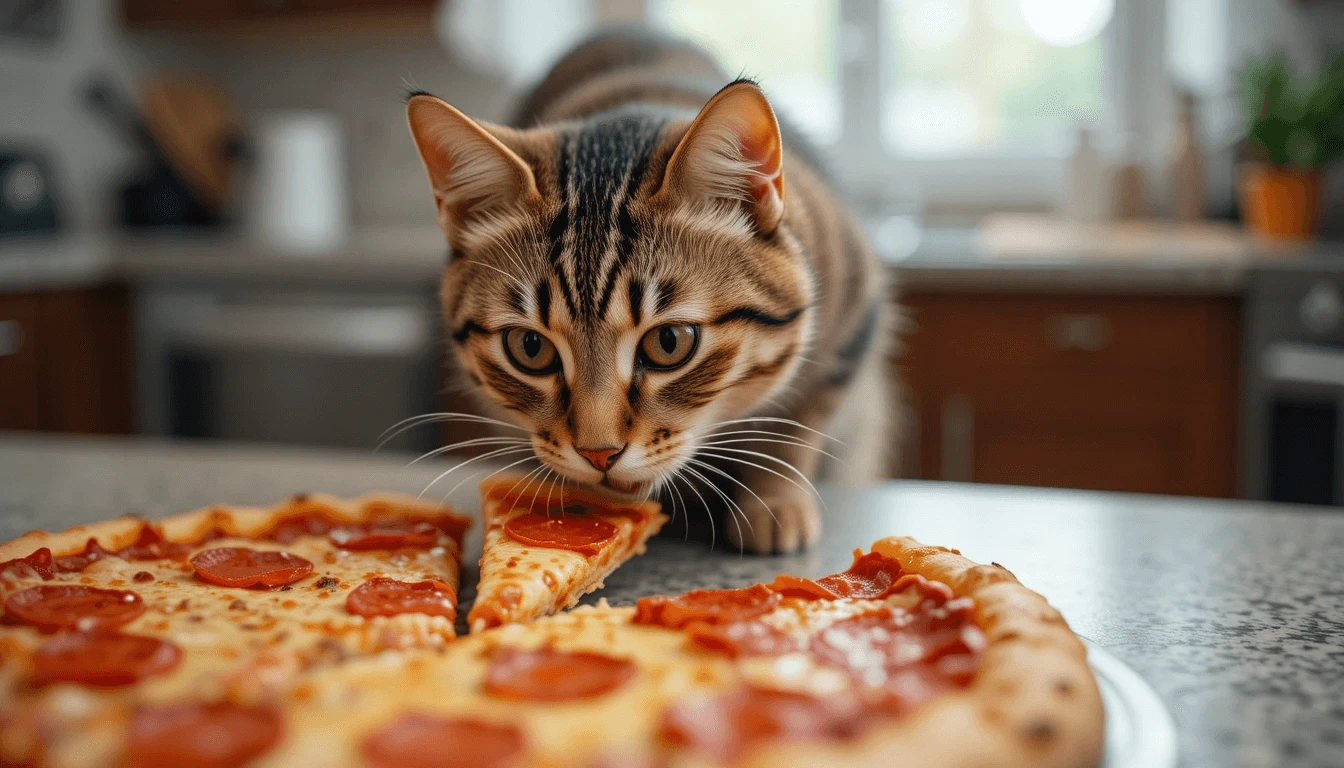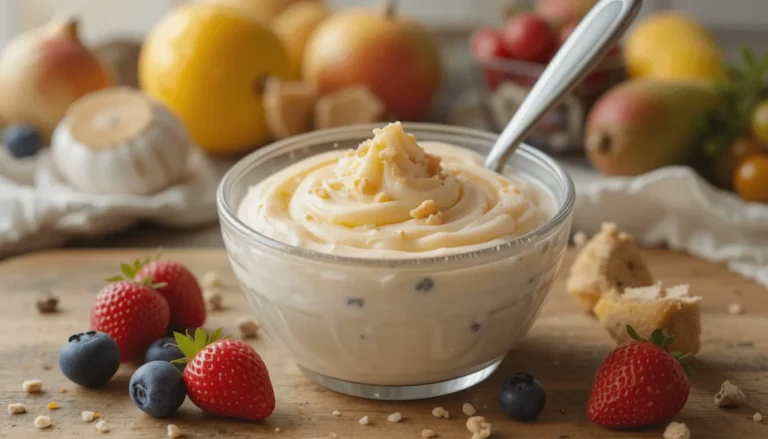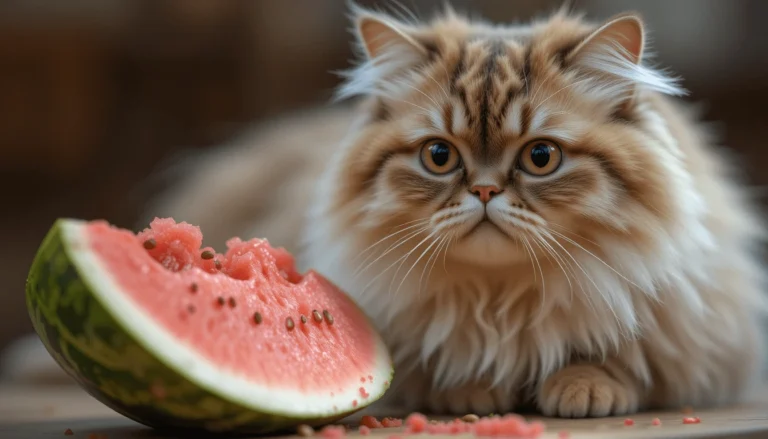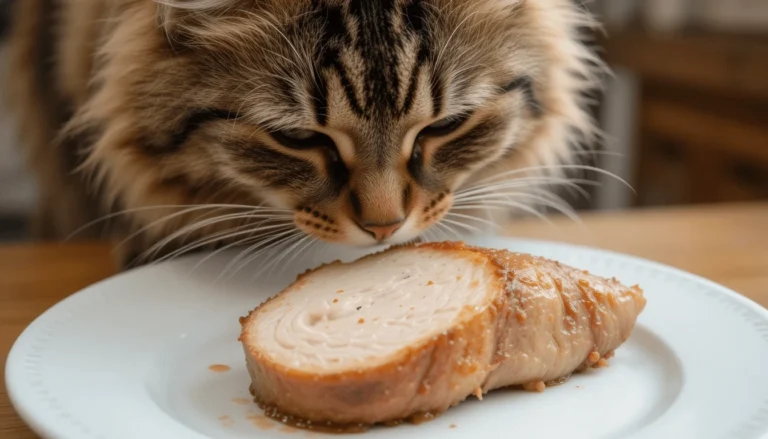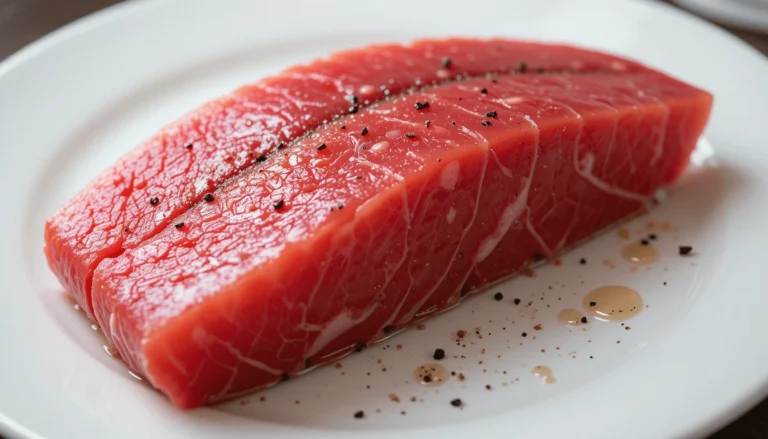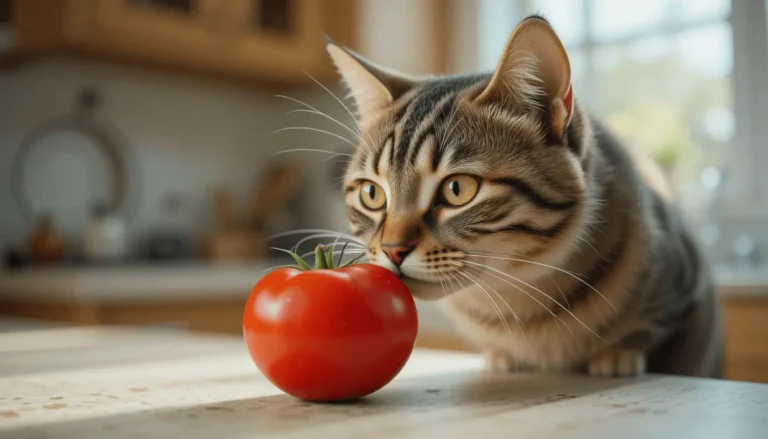Can Cats Eat Pizza? The Risks of Feeding Your Cat Human Food
Introduction
“As you settle into the couch with a slice of pepperoni pizza, your cat leaps onto your lap, eyes fixed on your meal. Those pleading eyes make it tempting to share a bite—but can cats eat pizza safely? The answer might surprise you. While pizza is a human favorite, its ingredients (like garlic, cheese, and processed meats) pose serious risks to feline health. Let’s explore why pizza is a dangerous snack for cats and what to offer instead.”
Why Pizza Is Dangerous for Cats
At first glance, pizza might appear to be a relatively benign human food—after all, it contains meat, dairy, and vegetables. However, nearly every component of a typical pizza carries hidden risks for feline health. Let’s break down the three primary dangers:
Toxic Ingredients
Many pizza staples are outright poisonous to cats. Garlic and onions, common in sauces and toppings, contain thiosulfates that destroy red blood cells, potentially leading to life-threatening anemia. According to the ASPCA Animal Poison Control Center, even small amounts—about 1 gram per 5 pounds of body weight—can cause toxicity.
Tomatoes, while less dangerous, contain solanine and are highly acidic. These compounds may induce gastrointestinal inflammation, potentially resulting in emesis or loose stools. The tomato plant itself is more toxic than the fruit, but it’s best to avoid both.
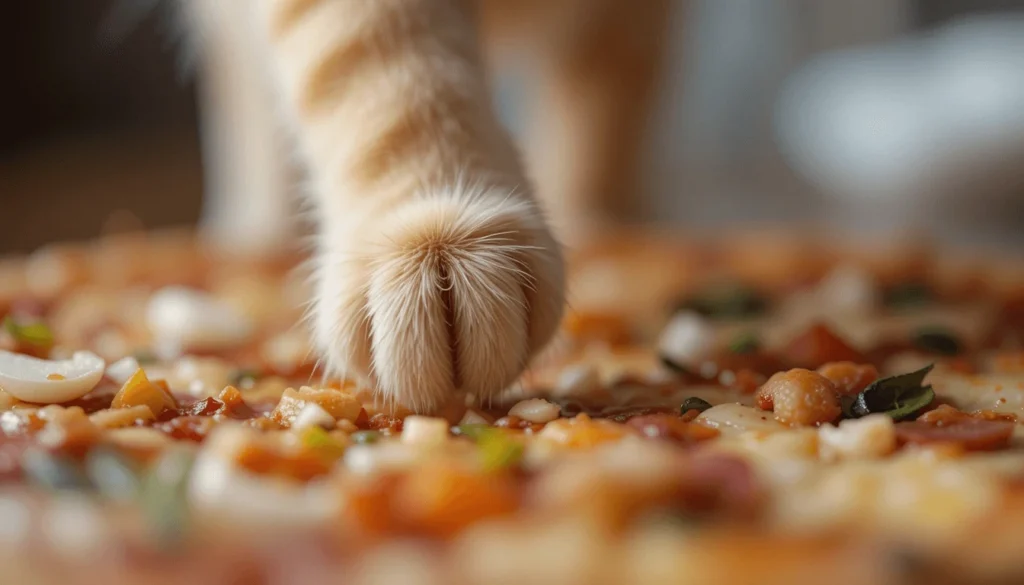
Dairy Problems
That stretchy mozzarella might be pizza’s crowning glory, but it’s a digestive nightmare for most cats. After weaning, felines lose about 90% of their lactase enzymes, making them lactose intolerant. A study published in the Journal of Veterinary Internal Medicine found that dairy products induce gastrointestinal distress in 58% of adult cats.
Symptoms like bloating, gas, and diarrhea typically appear within 12 hours of consumption. While some cats tolerate small amounts of hard cheeses better than milk, pizza’s high-fat cheeses (like ricotta or cream cheese) are particularly problematic.
High Fat & Salt Content
The combination of cured meats and high-fat dough in pizza presents multiple risk factors for cats:
- Pancreatitis Risk: The high fat content in pepperoni, sausage, and even plain cheese can inflame a cat’s pancreas. Veterinary clinics report a 40% increase in pancreatitis cases during holidays when human food sharing peaks (Veterinary Emergency Group, 2022).
- Obesity & Diabetes: A single slice of pizza can contain up to 300 calories—nearly half a cat’s daily requirement. Frequent ingestion can contribute to obesity and the development of metabolic disorders like diabetes.
- Kidney Strain: Processed meats pack up to 400mg of sodium per ounce. Cats’ kidneys aren’t designed to handle this much salt, potentially leading to hypertension or chronic kidney disease.
Common Pizza Toppings That Harm Cats
While pizza might be a crowd-pleaser for humans, many of its most popular toppings can be downright dangerous for our feline friends. Let’s take a closer look at why these common pizza additions should stay off your cat’s menu:
Pepperoni & Processed Meats
These savory toppings might be your favorite part of the pizza, but they’re a health hazard for cats:
- Excessive Sodium – Just one slice of pepperoni pizza can contain over 300mg of sodium, nearly half of a cat’s recommended daily limit. High salt intake can lead to dehydration, increased thirst, and long-term kidney strain.
- Preservatives & Additives – Processed meats often contain nitrates, nitrites, and other preservatives that can be toxic to cats in large amounts.
- High Fat Content – The grease from cured meats can trigger pancreatitis, a painful and potentially life-threatening inflammation of the pancreas.
Did you know? A study published in the Journal of Feline Medicine and Surgery found that cats fed high-sodium diets were 3 times more likely to develop kidney issues compared to those on balanced diets.
Mushrooms
While store-bought button mushrooms might seem harmless, they can still cause problems:
- Wild Mushroom Risk – If you forage for mushrooms, be extra cautious—many wild varieties (like Amanita species) are highly toxic to cats, causing liver failure or neurological damage.
- Digestive Upset – Even non-toxic mushrooms can be difficult for cats to digest, potentially leading to vomiting or diarrhea.
- Unknown Seasonings – Pizza mushrooms are often cooked with garlic or onions, compounding the danger.
Veterinary Insight: The Pet Poison Helpline reports that mushroom toxicity cases spike in autumn when wild mushrooms are more abundant.
Herbs & Spices
That fragrant pizza seasoning isn’t doing your cat any favors:
- Oregano & Basil – While not deadly, these herbs can irritate a cat’s digestive system, leading to mild stomach upset.
- Garlic Powder – Often found in pizza seasonings, even small amounts can damage red blood cells over time.
- Chili flakes contain capsaicin which triggers oral inflammation and hypersalivation in felines.
Pro Tip: If your cat accidentally licks a seasoned crust, monitor for signs of discomfort like lip-licking or pacing.
Safe Alternatives to Pizza for Cats
Just because pizza is off the table doesn’t mean your cat has to miss out on tasty treats. Here are some healthy, cat-approved alternatives:
Plain Cooked Meat
A simple, protein-packed option that satisfies their carnivorous cravings:
- Boiled Chicken or Turkey – Shredded, unseasoned poultry is easy to digest and packed with lean protein.
- Freeze-Dried Meat Treats – Look for single-ingredient options like chicken hearts or liver for a crunchy snack.
- Fish in Moderation – Small amounts of cooked salmon (boneless!) provide omega-3s, but avoid raw fish due to parasite risks.
Nutritional Bonus: A 1-ounce piece of plain chicken breast offers about 9g of protein—perfect for maintaining muscle mass.
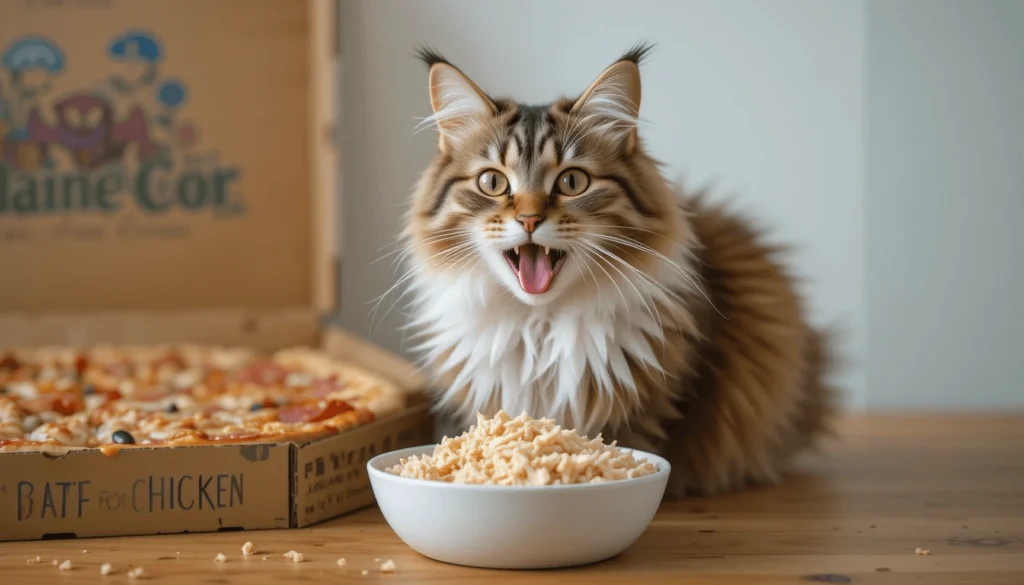
Cat-Specific Treats
Designed with feline nutrition in mind:
- Dental Health Treats – Helps reduce plaque while rewarding your cat.
- Soft Training Treats – Ideal for portion control and positive reinforcement.
- Fortified Snacks – Many commercial treats include taurine, an essential amino acid for heart and eye health.
Did You Know? The global cat treat market is projected to reach $5.2 billion by 2025, with increasing demand for natural, grain-free options.
Vegetable Snacks (For Adventurous Cats)
Some felines enjoy the occasional veggie nibble:
- Steamed Carrots – Soft, sweet, and rich in beta-carotene (but always served in tiny pieces).
- Green Beans – Low-calorie and fiber-rich, great for weight management.
- Pumpkin Puree – A teaspoon can aid digestion (ensure it’s plain, not pie filling!).
Fun Fact: Only about 15% of cats show interest in vegetables, so don’t be surprised if yours turns up their nose!
Conclusion
While those pleading eyes might tempt you to share a bite of your pizza, the risks simply aren’t worth it. From toxic ingredients like garlic and onions to digestive issues caused by dairy and high-fat toppings, pizza poses multiple dangers to feline health. Instead, opt for safe, cat-friendly alternatives like plain cooked meats, vet-approved treats, or the occasional veggie snack (if your cat enjoys them).
By understanding what foods are harmful and which are safe, you can keep your feline friend happy and healthy—without the guilt of denying them a slice. After all, isn’t their well-being more important than a momentary treat?
Additional Resources
- Safe Or Not ? Cat Food Guide
- ASPCA Animal Poison Control – Emergency toxin information
- Cornell Feline Health Center – Nutritional guidelines for cats
- VCA Hospitals – Human Foods Toxic to Cats – Comprehensive list of dangerous foods
FAQs
1. What should I do if my cat accidentally eats pizza?
Monitor for symptoms like vomiting, diarrhea, lethargy, or loss of appetite. If they consumed garlic, onions, or a large amount of cheese, contact your vet immediately.
2. Can cats have a tiny piece of plain cheese pizza?
While a small bite might not cause immediate harm, dairy can still upset their stomach. It’s best to avoid it altogether.
3. Are there any human foods cats can safely eat?
Yes! Plain cooked chicken, turkey, or fish (boneless and unseasoned) are safe in moderation. Always introduce new foods slowly.
4. Why are onions and garlic so dangerous for cats?
They contain compounds that damage red blood cells, leading to anemia. Even small amounts can be toxic over time.
5. What’s the best alternative to pizza for cats?
High-protein, low-fat treats made specifically for felines are the safest choice.

